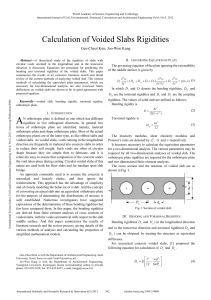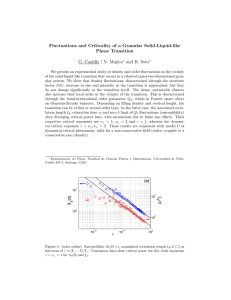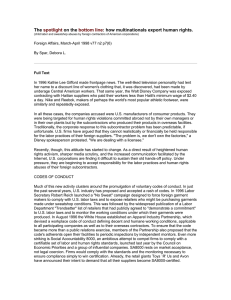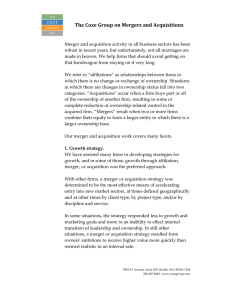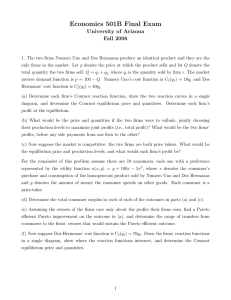Real rigidities are forces that reduc
Anuncio
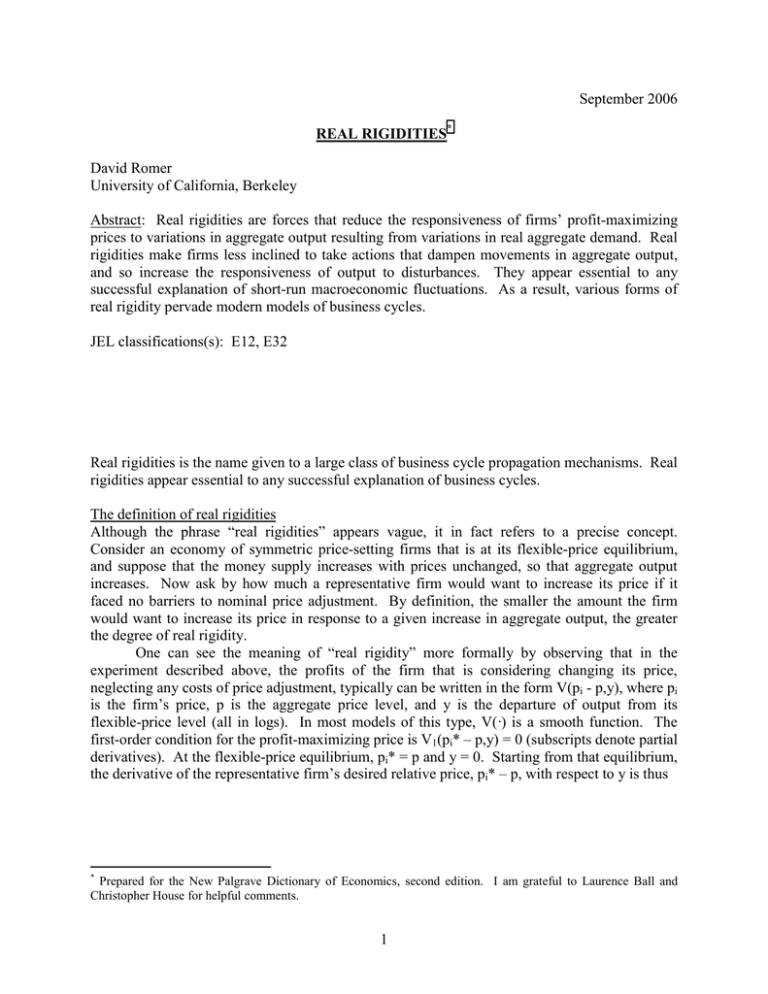
September 2006 REAL RIGIDITIES* David Romer University of California, Berkeley Abstract: Real rigidities are forces that reduce the responsiveness of firms’ profit-maximizing prices to variations in aggregate output resulting from variations in real aggregate demand. Real rigidities make firms less inclined to take actions that dampen movements in aggregate output, and so increase the responsiveness of output to disturbances. They appear essential to any successful explanation of short-run macroeconomic fluctuations. As a result, various forms of real rigidity pervade modern models of business cycles. JEL classifications(s): E12, E32 Real rigidities is the name given to a large class of business cycle propagation mechanisms. Real rigidities appear essential to any successful explanation of business cycles. The definition of real rigidities Although the phrase “real rigidities” appears vague, it in fact refers to a precise concept. Consider an economy of symmetric price-setting firms that is at its flexible-price equilibrium, and suppose that the money supply increases with prices unchanged, so that aggregate output increases. Now ask by how much a representative firm would want to increase its price if it faced no barriers to nominal price adjustment. By definition, the smaller the amount the firm would want to increase its price in response to a given increase in aggregate output, the greater the degree of real rigidity. One can see the meaning of “real rigidity” more formally by observing that in the experiment described above, the profits of the firm that is considering changing its price, neglecting any costs of price adjustment, typically can be written in the form V(pi - p,y), where pi is the firm’s price, p is the aggregate price level, and y is the departure of output from its flexible-price level (all in logs). In most models of this type, V(·) is a smooth function. The first-order condition for the profit-maximizing price is V1(pi* – p,y) = 0 (subscripts denote partial derivatives). At the flexible-price equilibrium, pi* = p and y = 0. Starting from that equilibrium, the derivative of the representative firm’s desired relative price, pi* – p, with respect to y is thus * Prepared for the New Palgrave Dictionary of Economics, second edition. I am grateful to Laurence Ball and Christopher House for helpful comments. 1 d(pi* - p) dy = V12(0,0) -V11(0,0) ≡ φ. pi*-p=0,y=0 For the flexible-price equilibrium to be stable, φ must be positive. By definition, a lower value of φ corresponds to greater real rigidity. Note that real rigidity is defined entirely in terms of relations among real variables: it refers to the (lack of) responsiveness of desired real prices to aggregate real output. The definition of real rigidity in models without symmetric price-setting firms is analogous: any force that reduces the amount that price-setters would change their relative prices in response to movements in aggregate output that are the result of changes in aggregate demand is a real rigidity. Real rigidities and business cycles Real rigidities are crucial to business cycles. At a general level, real rigidities make firms less inclined to take actions that dampen movements in aggregate output. As a result, they increase the responsiveness of output to disturbances. The importance of real rigidities is easiest to see in a static model where firms face fixed costs of changing prices. Consider the model sketched above, with two extensions. First, replace the profit function with a second-order approximation around the flexible-price equilibrium. This implies that the representative firm’s loss in profits from failing to charge its profit-maximizing price (neglecting costs of price adjustment) is K(pi - pi*)2, where K ≡ -V11. It also implies that the representative firm’s profit-maximizing price is given by pi* - p = φy, where φ is as defined before. Second, assume that each firm faces a fixed cost Z > 0 of changing its nominal price. The economy begins at its flexible-price equilibrium. We want to know by how much output can change in response to a change in aggregate demand before firms change their prices. Nonadjustment is an equilibrium as long as the representative firm’s losses from failing to adjust are less than Z. Prior to the shock, the representative firm’s price equals the aggregate price level, p. If the firm adjusts its price, it sets it to the new profit-maximizing level, p + φy. Thus 1 Z the condition for nonadjustment to be an equilibrium is K[p - (p + φy)]2 < Z, or y < . φ K Thus, when φ is lower — that is, when real rigidity is greater — the range over which aggregate demand shocks affect real activity is greater. Real rigidities are not just important to models with nominal rigidity, however. Consider, for example, the following minimalist real business cycle model. The markets for labor and goods are perfectly competitive, and the representative firm’s production function is yi = a + ni (y is output, a is productivity, and n is labor input, again all in logs). Labor supply is n = γw, γ > 0, where w is the (log) real wage. In this model, the elasticity of profit-maximizing relative prices to demand-driven output fluctuations (that is, to variations in y with a fixed, which must come from variations in n) equals the elasticity of the real wage with respect to y, which is 1/γ. Thus a larger value of γ corresponds to greater real rigidity. The production function implies that labor demand is perfectly elastic at w = a. Labormarket equilibrium therefore requires that n = γa. Thus a larger value of γ implies that 2 productivity shocks have a larger impact on employment, and thus that the output effects of the shocks are magnified to a greater extent. Thus even in this purely Walrasian model of fluctuations, real rigidity acts as a propagation mechanism. Real rigidities also act as amplification mechanisms in dynamic models of price adjustment. Consider an economy with barriers to price adjustment where output is above its flexible-price level, and suppose that some firms have an opportunity to change their prices, and that their new prices will be in effect for more than one period. Greater real rigidity increases the persistence of the departure of output from its flexible-price level, for three reasons. First, as in the static model of price adjustment, it reduces the benefits of price adjustment, and so makes firms more inclined not to adjust at all. Second, the fact that only some firms have the opportunity to adjust means that output will continue to be above its flexible-price level. Greater real rigidity then implies that the firms that adjust will respond by less, thus drawing out the period of above-normal output. Third, the fact that other firms will be in the same situation when they adjust their prices means that they will adjust by less, which in turn dampens the adjustments of the firms that adjust immediately. There is a close link between real rigidity and strategic complementarity in profitmaximizing prices. If we assume the stylized aggregate demand curve y = m - p (where m reflects factors that shift aggregate demand), then the expression for the representative firm’s profit-maximizing relative price, pi* - p = φy, implies pi* = φm + (1 - φ)p. Thus greater real rigidity corresponds to greater strategic complementarity in desired prices: when φ is lower, each firm wants its price to move more closely with other prices. Real rigidity and strategic complementarity in desired prices are not identical, however. To see this, suppose the aggregate demand equation is instead y = β(m - p), β > 0. Then pi* = φβm + (1 - φβ)p. Thus β affects strategic complementarity but not real rigidity. And it is real rigidity that is key to cyclical fluctuations. Nonetheless, because of the close link between the two concepts, and because many business cycle models assume y = m - p, the phrases real rigidity and strategic complementarity in prices are often used interchangeably. Types of real rigidities Since any force that reduces the responsiveness of profit-maximizing relative prices to demanddriven output fluctuations is a real rigidity, there are many possible real rigidities. Some might not be commonly thought of as “rigidities.” For example, as the simple real business cycle model shows, more elastic labor supply is a type of real rigidity. Such neoclassical sources of real rigidity, however, are almost surely not strong enough to generate output fluctuations of the size and nature of what we observe. In Walrasian models, the real wage is likely to rise sharply with the quantity of labor. For this not to occur, either the long-run elasticity of labor supply must be high, or the intertemporal elasticity of substitution in labor supply must be high and short-run aggregate fluctuations must have a large transitory component. Neither of these conditions appears to hold in practice. In models of barriers to nominal price adjustment, the result is large incentives for price changes, and thus little nominal rigidity. In productivity-driven real business cycle models, the result is small movements in labor input, so that the dynamics of aggregate output largely mimic the dynamics of the underlying productivity shocks. Researchers have therefore turned their attention to nonWalrasian sources of real rigidity. It appears difficult to understand substantial employment fluctuations without nonWalrasian real rigidities in the labor market. At a general level, what is needed is for some force 3 to cause workers to be off their labor supply curves, at least in the short run, so that the cyclical behavior of the real wage is not governed by the elasticity of labor supply. For example, if there is equilibrium unemployment because of efficiency wages, the cyclical behavior of the real wage depends on how the efficiency wage varies with aggregate output. As a result, the real wage can be (though it need not be) less procyclical than in a Walrasian labor market, with the result that fluctuations in employment and output are greater. A more subtle real rigidity in the labor market arises if labor is imperfectly mobile in the short run (because of search frictions, for example), so that each firm faces an upward-sloping labor supply curve rather than perfectly elastic supply at the economy-wide wage. Consider, for example, a firm contemplating cutting its price and increasing production in a recession. With imperfectly mobile labor, this requires paying a higher real wage. Thus the amount the firm wants to reduce its price is smaller — that is, real rigidity is greater. There can also be important real rigidities in other markets. In the goods market, forces making desired markups countercyclical act as real rigidities. When desired markups are more countercyclical, then, for a given degree of procyclicality of real marginal costs, desired movements in relative prices are smaller. Countercyclical desired markups can stem from a variety of sources. One simple but potentially important possibility is that when economic activity is greater, firms’ incentives to disseminate information and consumers’ incentives to acquire it are greater, and so demand is more elastic. Another feature of goods markets that can act as a real rigidity is input-output links among firms. If the prices charged by intermediate suppliers are sticky, the costs that firms face for intermediate inputs tend to rise by less than the suppliers’ costs in a boom, thereby reducing the amount that firms would raise their prices if they were free to do so. Capital-market imperfections can also create real rigidities. Capital-market imperfections can cause financing costs to be countercyclical, as higher output increases cash flow (and hence firms’ ability to use internal finance) and raises asset values (and hence increases collateral and reduces the cost of external finance). With one component of costs countercyclical, desired prices are less procyclical. To give another example, financial difficulties in recessions can make firms more interested in short-term profits relative to expanding their customer base, and so can make desired markups countercyclical. Although real rigidities appear essential to any successful model of business cycles, not all real rigidities are relevant to all business cycle models. For example, forces that affect what happens when one firm changes its price and others do not, such as limited short-run labor mobility among firms, are irrelevant to the properties of models with identical firms and fully flexible prices. In such models, only forces that affect what happens when all firms’ output moves together, such as the cyclical behavior of the real wage and of the elasticity of demand, are important. Nonetheless, as described above, real rigidities are critical even in such models. Selected literature Ball and Romer (1990) establish that in a static setting, imperfect competition and barriers to nominal adjustment alone are unlikely to generate substantial nominal rigidity. They show the general importance of real rigidities to static menu-cost models and stress that forces making desired real wages relatively unresponsiveness to output fluctuations are likely to be essential to generating substantial nominal rigidity (see also Blanchard and Fischer, 1989, Ch. 8). Earlier work by Akerlof and Yellen (1985) incorporates substantial real rigidity in a model of price stickiness, although it does not explicitly analyze the importance of real rigidity to the results. 4 Haltiwanger and Waldman (1989) show that strategic complementarity magnifies the impact of nonresponders on equilibrium outcomes, a result that is closely related to the finding that real rigidities magnify the effects of barriers to price adjustment. Kimball (1995) establishes the central role of real rigidities to the persistence of output fluctuations in models of staggered price adjustment, and stresses the importance of the distinction between forces that affect what happens when all firms change output and forces that affect what happens when one firm changes output with other firms’ output fixed (see also Blanchard, 1987). Romer (2006, Ch. 6) provides a general discussion of the importance of real rigidities to static and dynamic models of nominal rigidity, catalogues many specific real rigidities, and provides numerous references. Real rigidities pervade modern business cycle models. In real business cycle models, for example, such common features as indivisible labor supply, variable capital utilization and labor hoarding, and learning-by-doing (see, for example, Rogerson, 1988; Burnside and Eichenbaum, 1996; and Chang, Gomes, and Schorfheide, 2002) magnify the effects of disturbances precisely because they are real rigidities. On the price stickiness side, some important recent analyses where real rigidities play a central role include Mankiw and Reis (2002), Gertler and Leahy (2006), and Carvalho (2006). References Akerlof, George A., and Yellen, Janet L. 1985. A near-rational model of the business cycle, with wage and price inertia. Quarterly Journal of Economics 100, 823-838. Ball, Laurence, and Romer, David. 1990. Real rigidities and the non-neutrality of money. Review of Economic Studies 57, 183-203. Blanchard, Olivier Jean. 1987. Aggregate and individual price adjustment. Brookings Papers on Economic Activity, no. 1, 57-109. Blanchard, Olivier J., and Fischer, Stanley. 1989. Lectures on Macroeconomics. Cambridge: MIT Press. Burnside, Craig, and Eichenbaum, Martin. 1996. Factor-hoarding and the propagation of business-cycle shocks. American Economic Review 86, 1154-1174. Carvalho, Carlos. 2006. Heterogeneity in price stickiness and the new Keynesian Phillips curve. Unpublished paper, Princeton University. Chang, Yongsung, Gomes, Joao F., and Schorfheide, Frank. 2002. Learning-by-doing as a propagation mechanism. American Economic Review 92, 1498-1520. Gertler, Mark and Leahy, John. 2006. A Phillips curve with an Ss foundation. National Bureau of Economic Research Working Paper No. 11971. Haltiwanger, John, and Waldman, Michael. 1989. Limited rationality and strategic complements: The implications for macroeconomics. Quarterly Journal of Economics 104, 463-483. Kimball, Miles S. 1995. The quantitative analytics of the basic neomonetarist model. Journal of Money, Credit, and Banking 27, 1241-1277. Mankiw, N. Gregory, and Reis, Ricardo. 2002. Sticky information versus sticky prices: A proposal to replace the new Keynesian Phillips curve. Quarterly Journal of Economics 117, 1295-1328. Rogerson, Richard. 1988. Indivisible labor, lotteries and equilibrium. Journal of Monetary Economics 21, 3-16. Romer, David. 2006. Advanced Macroeconomics. Third edition. New York: McGraw-Hill. 5


